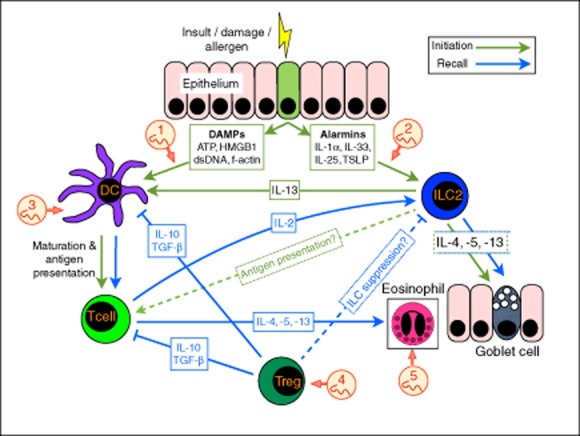Fig. 1.

Sooner and later. The immediate response to immunological insult (in the form of injury, allergens or other toxic products) that causes epithelial cell stress and death, is the release of damage-associated molecular patterns (DAMPs), such as adenosine triphosphate (ATP), dsDNA, high-mobility group box 1 (HMGB1) and f-actin. Concurrently with, or consequent to DAMP release, the alarmin cytokines interleukin (IL)-1α, IL-33, IL-25 and thymic stromal lymphopoietin (TSLP) are induced. Both DAMPs and alarmins result in activation of dendritic cells (DCs) and group 2 innate lymphoid cells (ILC2). The responses occurring soon after immune stimulus are coloured green. ILC2 produce the type 2 cytokines interleukin (IL)-4, IL-5 and IL-13, resulting in subsequent expansion of effector cell populations such as eosinophils and goblet cells which can occur at both early (green arrows) and late (blue arrows) phases. ILC2-derived IL-13 also induces maturation and migration of DCs to the draining lymph node, where DCs present antigen to naive T cells. Although ILC2 express major histocompatibility complex (MHC) class II, it is unknown whether they present antigen directly to T cells in vivo. Through the combined efforts of ILC2 and DC, antigen-specific T helper type 2 (Th2) cells differentiate, and produce type 2 cytokines, further stimulating, recruiting and activating type 2 effector cells, as well as IL-2, activating and expanding ILC2 cells (blue arrows). Regulatory T cells (Tregs) produce immunosuppressive cytokines such as IL-10 and transforming growth factor (TGF)-β, suppressing T cells and DC responses (blue solid line), and may also suppress ILC2 responses (blue dashed line). Helminths and their products are known to suppress through at least five key mechanisms (indicated in numbered red circles): (1) secretion of apyrases, enzymes which can degrade the inflammatory DAMP ATP to non-inflammatory adenosine monophosphate (AMP) 99,100; (2) secreted products which inhibit the release of IL-33 96; (3) a range of products suppress DC maturation to Toll-like receptor (TLR) signals 86–89; (4) secretions induce Tregs through the transforming growth factor (TGF)-β pathway 107; and (5) secreted enzymes degrade eotaxin, a chemokine required for eosinophil attraction 103.
